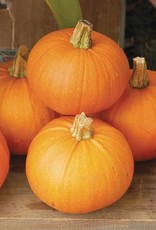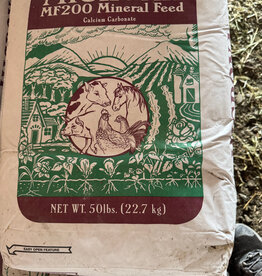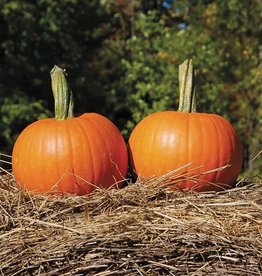HM New England Pie Pumpkin 1/8 OZ
| Availability: | In stock (17) |
Photo and Description Credit - High Mowing Seeds
Classic pie pumpkin with dry, stringless flesh and superior thick consistency in pies.
Attractive fruits have dark orange skin with light ribbing and well attached handles. Delicious flesh is not quite as sweet as Baby Pam but has even better texture.
- Stores well
- 4-6 lb fruit
C. pepo- 140-250 seeds/oz (175 avg), 2,300-4,000 seeds/lb (2,800 avg); C. moschata- 280-375 seeds/oz (310 avg), 4,500-6,000 seeds/lb (5,000 avg); C. maxima- 135-200 seeds/oz (155 avg), 2,200-3,200 seeds/lb (2,500 avg). M=1,000
Seeding Rate
Bush/Semi-bush- 10,000-15,000 seeds/acre, (C. pepo ~ 3.5-5.3 lbs., C. moschata ~ 2-3 lbs., C. maxima ~ 4-6 lbs.) using 2-3 seeds/18” on 6’ centers. Vining- 3,500-5,000 seeds/acre (C. pepo ~ 1.25-1.8 lbs., C. moschata ~ .7-1.0 lb., C. maxima ~ 1.4-2.0 lbs.), using 2-3 seeds/36” on 6’ centers.
Cultural Info
Pumpkins (Cucurbita spp.)are long-season tender annuals in the Cucurbitiacea family, which includes cucumbers, summer squash and winter squash, melons and gourds.
- Pie pumpkins are intended for eating and have been selected for flavor, texture and density of flesh.
- Specialty pumpkins have superior eating qualities in addition to their unique physical attributes. Jack O’
- Lantern pumpkins are strictly decorative, selected for shape, size, handle quality, uniformity, and durability.
Soil Nutrients and Requirements
Pumpkins grow best in fertile, well-drained soil, with pH between 5.8-6.8. Sidedressing is recommended one week after blossoming and again 3 weeks later, especially if there are signs of deficiency. Nitrogen deficiencies cause yellowing, and bronze leaves are a sign of potassium deficiency.
Seeding Depth
1/2-1”
Plant Spacing
For bush varieties 18”, for vining 24-36”. Tighter plant spacing will result in yields of smaller, but more numerous, fruit.
Row Spacing
Row spacing: for bush/semi-bush and short vine types 6’, for vigorous vining types use 9-12’.
When to Sow
Days to maturity are from direct seeding, subtract 2 weeks if transplanting. Seeds can be direct seeded after danger of frost has passed and soil temperature has reached 70°F. Start transplants indoors 3-4 weeks before last risk of frost. Optimal soil temperature for germination is 85-95°F.
Other Considerations
Black plastic mulch and floating row cover can also be used to increase soil and air temperature, as well as ward off cucumber beetles which eat young seedlings and spread disease. Remove row cover when flowers open to allow for insect pollination.
Harvest
Harvest by cutting stem near vine or at least 2-3” from fruit. Too many days of sun on fruits after maturity will bleach handles and cause sun scald on the fruit.
Storage
A short or broken stem can lead to rot. Cure after harvest by keeping in a warm, dry location for a few days then store at 50-55°F with 55-75% relative humidity and good air circulation. Delicata and acorn squash do not need curing, but will not store as long as other varieties.
Pest Info
- Striped cucumber beetles cause feeding damage to the leaves, and often transmit bacterial wilt. Larvae feed on the plant roots. Row covers can provide effective protection, but must be removed during flowering to allow pollination. Practice crop rotation and good sanitation to eliminate overwintering habitat. Frequent application of kaolin clay and/or pyrethrum have shown some effective control.
- Squash vine borer will cause plants to look wilted even when moisture is plentiful. Slice open stem and remove and destroy.
- Squash bugs can be controlled by handpicking. Bury or compost plant residues at the end of the season.
Disease Info
- Powdery mildew, caused primarily by the fungus Sphaerotheca fuliginea, results in reductions in overall yields and quality of harvested fruit. Powdery mildew does not overwinter in the northeast (spores cannot withstand cold and cannot persist in the absence of host tissue) but blows north every year from southern states where crops are planted earlier. Powdery mildew is difficult to control with fungicide applications, even conventional ones, because the fungi multiply rapidly and attach to the undersides of leaves where they are difficult to reach with sprays. Many newer pumpkin varieties have been developed with tolerance to powdery mildew (PMT). Plants can still become infected but the symptoms are usually much less severe.
- Pumpkins are also subject to several fruit rots, of which the most common is probably black rot, caused by the same fungus that causes gummy stem blight (Didymella bryoniae). Recent research indicates that control measures for powdery mildew, including the use of PMT varieties, is also effective against black rot. In the case of black rot, the pathogen can be seed-borne and survive in crop residues.
- Scab – Avoid wetting foliage and give plants plenty of space for circulation.





